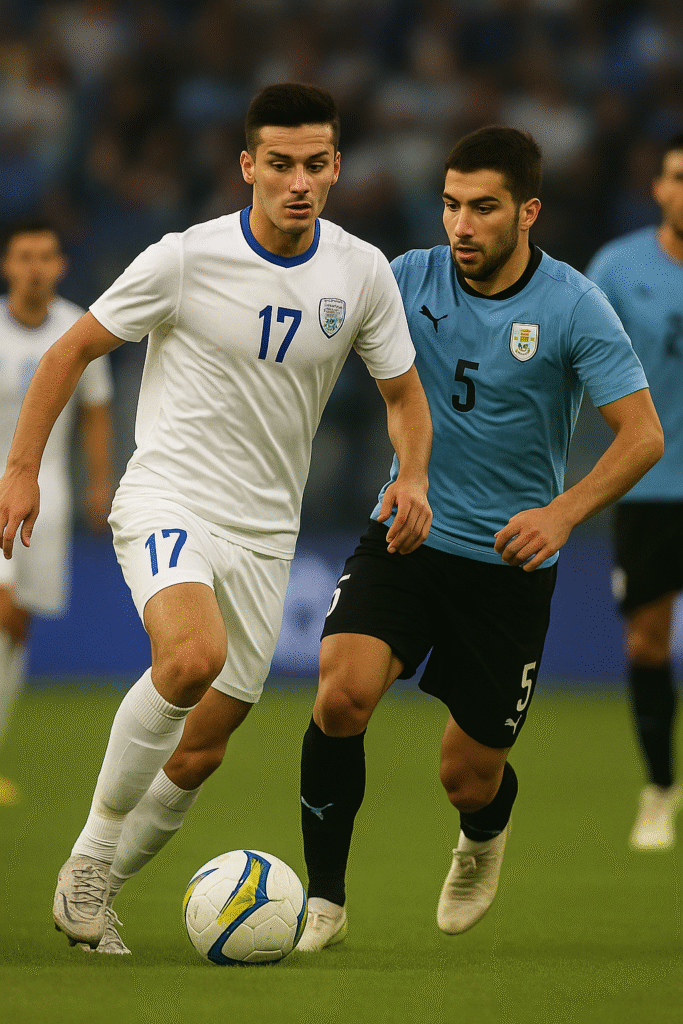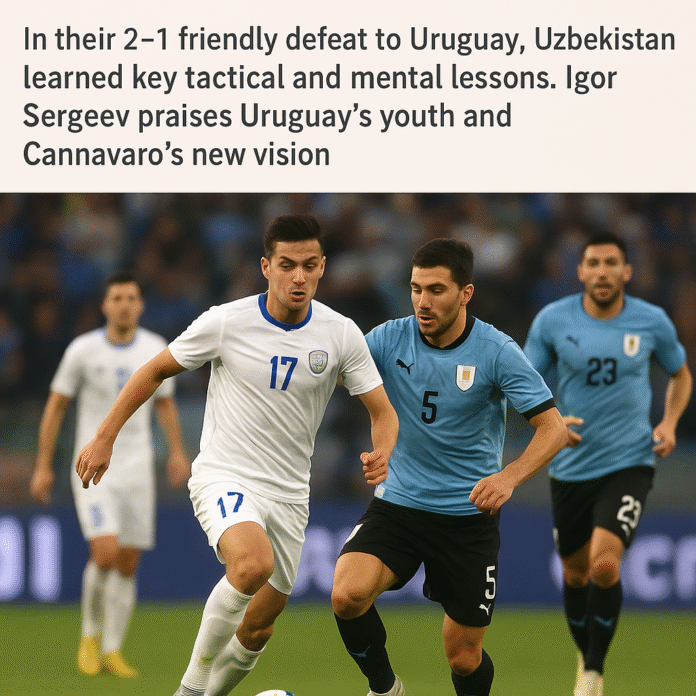Uzbekistan vs Uruguay: Analysis of Uruguay’s Talented Youth by Igor Sergeev
The world of international football friendlies often reveals more than simple exhibition match results. When Uzbekistan faced Uruguay in a preparatory friendly, the encounter represented far more than routine international calendar obligation—it offered a genuine test of tactical evolution, squad depth evaluation, and competitive mentality for both nations pursuing different but equally important objectives.
Igor Sergeev, the experienced Uzbek midfielder, provided fascinating insights into his team’s mindset approaching this challenging fixture. His observations about Uruguayan talent, preparation strategies, and environmental challenges paint a comprehensive picture of modern international football’s complexities, particularly for nations like Uzbekistan working to establish themselves among global competition’s upper echelons.
Sergeev’s role within the Uzbek national team extends beyond his on-field contributions. As a veteran presence in a squad undergoing transformation under new management, his perspective carries weight. His experience playing professionally in Thailand prepared him for the climatic challenges this match presented, while his tactical understanding allowed him to appreciate the quality Uzbekistan faced regardless of which Uruguayan players took the field.
The match itself, ultimately won 2-1 by Uruguay, confirmed many of Sergeev’s pre-match assessments. But the real value lies in examining how Uzbekistan approached this test, what it revealed about both teams’ current states, and how such encounters fit into the broader narrative of nations preparing for World Cup 2026 qualification and participation.
The Strength of Young Uruguayan Talent: An Opponent Not to Be Underestimated
Moving Beyond the Notion of “Second Team”: The Exceptional Competence of Reserves
One of Sergeev’s most important pre-match observations challenged the common misconception that friendly matches featuring rotated squads represent diminished competition. When Uruguay’s coaching staff selected a lineup featuring numerous players who don’t regularly start competitive fixtures, casual observers might have assumed Uzbekistan faced a weakened opponent. Sergeev emphatically rejected this interpretation.
“There is no such thing as a ‘main team’ or ‘second team’ when discussing Uruguay,” Sergeev explained, recognizing a fundamental truth about elite football nations. Uruguay’s player development system and competitive domestic leagues produce such depth that even squad members who don’t feature in competitive starting lineups possess exceptional quality. These aren’t dramatically inferior players grateful for occasional opportunities—they’re legitimate international-caliber footballers who happen to play for a nation with extraordinary depth at their positions.
This distinction matters enormously for preparation and mindset. If Uzbekistan approached the match assuming they faced Uruguay’s “B-team” and therefore enjoyed tactical advantages or could expect comfortable victory, they would have been devastated tactically and psychologically when reality contradicted those assumptions. Sergeev’s comments suggest Uzbekistan’s coaching staff and players maintained proper respect for their opponents regardless of names on the team sheet.
Uruguay’s youth development success reflects decades of investment in football infrastructure, coaching education, and talent identification systems. The country produces far more elite players than its population of 3.5 million would suggest possible. This overproduction creates the “luxury problem” where genuinely excellent players struggle to earn regular national team places simply because they compete against even better players at their positions.
Consider the psychological dynamics for these reserve players. They train alongside Uruguay’s established stars, compete for positions in one of South America’s most successful national teams, and carry the weight of knowing that exceptional club performances might not translate to national team opportunities given the competition they face. When finally selected for friendlies or rotational opportunities, these players approach matches with intensity that belies the “friendly” designation—they’re not casually going through motions but desperately trying to force their way into coaches’ long-term plans.
Sergeev recognized this competitive hunger in Uruguay’s selected squad. The young Uruguayan players weren’t treating this as a relaxed exhibition but as a crucial audition. This understanding informed Uzbekistan’s tactical approach and mental preparation—they knew they would face opponents playing with something to prove, making the friendly competitive and physically demanding regardless of which Uruguay players participated.
Individual Motivation of Uruguayan Players to Prove Themselves
Expanding on his “no second team” observation, Sergeev highlighted the individual motivation driving each Uruguayan player selected for the friendly. “Every Uruguayan player is motivated and eager to assert themselves,” he noted, recognizing that squad rotation creates internal competition that benefits national team quality.
In established football powers like Uruguay, earning and maintaining national team selection requires constant excellence. Players cannot relax after breaking into the squad—they must continuously perform at their highest levels or risk being displaced by hungry competitors. This creates an environment where even friendly matches become high-stakes auditions for players on the national team periphery.
The motivation operates on multiple levels. First, players want proving to their current coaches that they deserve greater consideration for competitive fixtures. Strong friendly performances can shift coaching perceptions and open doors to World Cup qualification matches or tournament rosters. Second, players recognize that international scouts and clubs monitoring these matches evaluate their performances, potentially influencing club transfer opportunities. Third, personal pride drives athletes—no competitive footballer wants to be remembered as someone who couldn’t capitalize on national team opportunities.
For young players in particular, these friendly appearances might represent their first significant international exposure. They’re not just competing against Uzbekistan; they’re announcing themselves to the global football community. A impressive performance could launch a career trajectory leading to European clubs and regular national team inclusion. Conversely, a poor showing might relegate them to domestic football obscurity despite their underlying talent.
Sergeev’s recognition of this motivation shaped Uzbekistan’s tactical approach. They couldn’t afford assuming Uruguayan players would lack intensity or commitment simply because the match carried no competitive stakes. Instead, Uzbekistan prepared for opponents who would press aggressively, compete ferociously for every ball, and maintain concentration throughout the ninety minutes—exactly the intensity competitive matches demand.
This competitive dynamic benefits both nations. Uruguay evaluates squad depth under genuine match conditions rather than training simulations, while Uzbekistan experiences the intensity and quality they’ll face in major tournaments if they successfully navigate World Cup qualification. The friendly label might suggest casual exhibition, but the actual contest reflected serious competitive football.
Uzbekistan’s Preparation Strategy for a Crucial Match
The Imperative of Concentration and Video Analysis of the Opponent
Modern international football preparation extends far beyond physical training and tactical drills. Video analysis has become absolutely essential for understanding opponents’ tendencies, identifying exploitable weaknesses, and preparing players mentally for the challenges they’ll face. Sergeev emphasized this analytical component when discussing Uzbekistan’s preparation approach.
“The team must concentrate on effective preparation,” Sergeev stated, highlighting that facing elite opposition requires meticulous attention to detail that can’t be achieved through generic training. Uzbekistan’s coaching staff needed studying Uruguay’s recent matches, identifying patterns in their attacking build-up, recognizing defensive vulnerabilities, and understanding individual player characteristics that might create tactical opportunities.
Video analysis serves multiple functions in modern football preparation. First, it allows coaches to demonstrate specific tactical concepts they want implementing. Rather than describing verbally how Uruguay’s fullbacks push forward in possession, coaches can show actual match footage illustrating these patterns and explaining how Uzbekistan might exploit the spaces this creates. Second, video helps players mentally rehearse game situations. Seeing Uruguay’s pressing triggers, defensive shape, and transition patterns allows Uzbekistan players to visualize their responses before experiencing them in real time.
Third, video analysis identifies individual matchups that might prove crucial. If Uruguay features a particularly dangerous winger who drifts inside to receive passes between lines, Uzbekistan’s defensive midfielder can study this player’s movement patterns and prepare to track these runs. If Uruguay’s center-backs struggle against pace on the counter-attack, Uzbekistan’s forwards can prepare to exploit this weakness through quick transitions.
The concentration Sergeev mentioned extends beyond video analysis to encompass mental preparation for the match’s demands. Facing Uruguay—even a rotated Uruguay squad—represents a step up in quality from many opponents Uzbekistan regularly encounters. Players need mentally preparing for the game’s speed, the technical precision of their opponents, and the physicality South American teams typically bring. Losing concentration for even brief periods against this caliber opponent results in conceded goals and momentum shifts that determine match outcomes.
Effective preparation also requires honest self-assessment. Uzbekistan’s coaches needed identifying their own vulnerabilities and preparing defensive strategies to minimize Uruguay’s ability to exploit these weaknesses. If Uzbekistan struggles defending crosses from wide positions, preparation must emphasize compacting central areas and improving aerial duel success rates. If transition defense represents a weakness, preparation emphasizes recovery runs and defensive organization after possession loss.
The New Chapter Under Fabio Cannavaro’s Leadership
The match represented a significant milestone for Uzbekistan beyond the immediate result—it marked an important test under new manager Fabio Cannavaro’s tactical guidance. When national teams change managers, particularly bringing in high-profile international coaches, transition periods follow where new philosophies, systems, and expectations get implemented.
Cannavaro, the legendary Italian defender and 2006 World Cup winner, brought credibility and tactical sophistication to Uzbekistan’s program. His appointment signaled the federation’s ambitions to elevate the national team from regional competitor to genuine Asian power capable of reaching World Cups and competing effectively once there. But reputation alone doesn’t guarantee success—Cannavaro needed demonstrating that his tactical vision suited Uzbekistan’s playing personnel and competitive environment.
The Uruguay friendly provided Cannavaro an opportunity to evaluate his squad against elite opposition without competitive consequences hanging over the result. He could experiment with formations, test different player combinations, and assess how his tactical principles functioned against technically superior opponents. These evaluations prove invaluable for developing the understanding necessary to navigate competitive fixtures where mistakes carry serious consequences.
For players, adapting to new management creates challenges and opportunities. Cannavaro’s arrival potentially reshuffled the squad hierarchy—players who thrived under previous management might find themselves struggling to fit new tactical demands, while others who previously sat on the periphery might discover their skills align perfectly with Cannavaro’s preferences. The Uruguay match allowed players to demonstrate their adaptability and prove they deserved continued or increased roles under the new regime.
Sergeev’s characterization of this as an “important test” reflects understanding that friendly results matter less than the lessons learned and progress demonstrated. If Uzbekistan competed well tactically, showed cohesion in implementing Cannavaro’s system, and demonstrated the intensity required at this level, then even a loss would represent positive progress. Conversely, a victory achieved through disorganized play or individual brilliance despite tactical confusion would reveal ongoing challenges requiring attention.
The new chapter under Cannavaro also connected to broader ambitions. Uzbekistan aims to qualify for the 2026 World Cup, which expands to 48 teams and creates additional qualification spots for Asian nations. This expansion offers realistic hope for teams like Uzbekistan who’ve historically fallen just short of qualification. But capitalizing on this opportunity requires elevating performance levels and consistently competing against Asia’s established powers. Cannavaro’s appointment and matches like the Uruguay friendly represent steps in this developmental journey.
Environmental Factors and Mindset
Adaptation to Hot and Humid Climate Conditions (Sergeev’s Experience)
International football requires athletes to perform optimally despite dramatically varying environmental conditions. The climate where Uzbekistan faced Uruguay—hot and humid conditions quite different from Central Asian weather patterns—presented genuine physiological challenges that could significantly impact match performance if not properly managed.
Sergeev’s confidence addressing these conditions stemmed from his professional experience playing in Thailand, where similar heat and humidity define the playing environment. “I feel ready thanks to my previous experience in Thailand,” Sergeev explained, recognizing that his body had already adapted to performing in these demanding conditions. This experience provided him psychological confidence and practical knowledge about pacing himself, hydration needs, and physical sensations to expect during the match.
Heat and humidity create multiple performance challenges for footballers. Cardiovascular demands increase as bodies work harder to maintain safe core temperatures through perspiration and heat dissipation. Dehydration risk accelerates, requiring careful hydration protocols before, during, and after matches. Mental fatigue accumulates more quickly as physiological stress compounds the concentration demands of elite competition. Muscle cramping becomes more likely as electrolyte balance gets disrupted through excessive sweating.
For players unaccustomed to these conditions, the performance impact can be dramatic. Athletes who normally maintain high intensity for ninety minutes might find themselves exhausted after sixty. Decision-making quality deteriorates as mental fatigue sets in. Technical execution suffers when physical discomfort distracts from football fundamentals. Teams that fail to prepare adequately for environmental challenges often suffer second-half collapses as accumulated fatigue overwhelms their competitive intentions.
Uzbekistan’s preparation likely included acclimatization protocols designed to help players adapt before the match. These might involve arriving several days early to allow physiological adjustment, conducting training sessions during the hottest parts of the day to simulate match conditions, and implementing hydration and nutrition strategies optimized for heat performance. Players like Sergeev with relevant experience could mentor teammates on managing these conditions effectively.
The environmental challenge also created tactical considerations. Teams playing in extreme heat often adopt more conservative playing styles that minimize energy expenditure. Pressing intensity might decrease to preserve energy for crucial moments. Possession strategies might emphasize controlling tempo rather than rapid vertical attacks that require repeated high-intensity sprints. Substitutions become more important for maintaining fresh legs as starters tire earlier than they would in temperate conditions.
Sergeev’s comfort with the conditions provided Uzbekistan a valuable advantage. His ability to maintain performance levels while teammates potentially struggled gave his team a reliable player who could influence the match throughout its duration. This experience differential might prove decisive in tight matches where late-game fitness determines which team can impose their will during crucial moments.
Optimism and Determination of Uzbek Players Before Kickoff
Beyond tactical and physical preparation, mental readiness determines how teams perform under pressure. Sergeev’s comments revealed that Uzbekistan approached the match with appropriate confidence and determination despite facing prestigious opposition. “The team is entirely focused on the match and determined to give their best,” he stated, describing a squad mentally prepared for the challenge ahead.
This determination stemmed partly from national pride. Representing your country in international competition carries emotional weight that transcends individual match results. Players understand they’re not just competing for personal achievement but defending their nation’s honor and representing millions of compatriots following their performance. This responsibility motivates extraordinary effort and commitment that can overcome talent disadvantages.
Sergeev explicitly mentioned the team’s desire “to defend the honor of the country regardless of the opponent.” This statement reflects the mentality required in international football—you cannot pick and choose when to compete fully based on opponent prestige or perceived chances of victory. Every match demands maximum commitment and professional pride regardless of competitive context. Uzbekistan couldn’t afford approaching Uruguay casually despite the friendly designation or the competitive quality differential.
The optimism Sergeev described didn’t suggest naive confidence in easy victory but rather belief in their ability to compete effectively. Uzbekistan’s players recognized the quality they faced but didn’t feel intimidated or defeated before kickoff. This psychological balance—respecting opponents while believing in your own capabilities—defines successful underdogs who compete above expectations.
Team focus represents another crucial mental component Sergeev highlighted. In the days and hours before significant matches, distractions multiply. Media obligations, travel logistics, and the general excitement of facing prestigious opponents can fragment players’ attention. Maintaining focus requires discipline and collective commitment to preparation priorities over peripheral concerns.
The determination to give their best, regardless of eventual results, reflects professional maturity. Players understand that outcomes sometimes depend on factors beyond their complete control—opponent quality, referee decisions, fortunate or unfortunate bounces—but effort and commitment remain entirely within their control. Teams that emphasize controllable factors and judge themselves by performance quality rather than results alone tend to develop resilience that serves them well throughout competitive cycles.

This mental preparation connected directly to Uzbekistan’s broader ambitions. The Uruguay friendly represented one step in their journey toward World Cup qualification for 2026. Building a team culture that competes fearlessly against all opponents, maintains focus under pressure, and takes pride in representing their nation creates the foundation necessary for navigating the long, challenging qualification process ahead.
Conclusion: The Friendly Match as a Crucial Step Toward World Cup 2026
The Uzbekistan-Uruguay friendly, despite its exhibition designation, carried genuine significance for both participating nations. For Uruguay, it provided opportunities to evaluate squad depth, give valuable international experience to promising young players, and maintain match sharpness during a break from competitive fixtures. For Uzbekistan, it offered a measuring stick against elite opposition, a chance to implement Fabio Cannavaro’s tactical vision under pressure, and psychological preparation for the quality they’ll face in World Cup qualification.
Uruguay’s 2-1 victory confirmed their superior quality but also demonstrated that Uzbekistan could compete respectably against South American opposition. The scoreline, while disappointing for the Central Asian side, wasn’t the embarrassing margin that would have suggested they’re nowhere near ready for elite international competition. Instead, it revealed a team that can hold its own against quality opposition while acknowledging areas requiring continued development.
Igor Sergeev’s pre-match insights proved prescient. Uruguay’s rotated squad indeed featured young players competing with intensity and quality that challenged Uzbekistan throughout. The preparation emphasis on concentration and video analysis allowed Uzbekistan to compete tactically rather than being overwhelmed by superior individual quality. Cannavaro gained valuable information about his squad’s capabilities and tactical adaptability. And Sergeev’s experience managing hot, humid conditions proved valuable as environmental factors influenced match dynamics.
Looking forward, matches like this Uruguay friendly serve crucial developmental purposes for nations like Uzbekistan aspiring to reach World Cups. They expose players to the speed, technical quality, and physical intensity they must handle consistently to succeed at the highest levels. They reveal tactical lessons about what works and what requires adjustment when facing elite opponents. They build mental resilience by demonstrating that prestigious teams are beatable rather than mythically superior.
The road to World Cup 2026 requires Uzbekistan to string together excellent performances across multiple years of qualification matches. They’ll face Asian powers like Japan, South Korea, Australia, and Iran—teams that regularly reach World Cups and compete effectively once there. The lessons learned against Uruguay—about maintaining concentration, competing with intensity regardless of opponent reputation, adapting to challenging conditions, and implementing cohesive tactical plans under pressure—will prove invaluable throughout this qualification journey.
Sergeev and his teammates left the Uruguay match with renewed understanding of their current level and the work remaining before they can consistently compete with global football’s elite. But they also gained confidence from competing respectably against a proud football nation, validation that their preparation methods and tactical approach can function against quality opposition, and motivation to continue their developmental trajectory under Cannavaro’s leadership. These intangible benefits, perhaps even more than the tactical lessons learned, justify the value of friendlies that might otherwise seem like meaningless exhibitions. For Uzbekistan, the path to World Cup 2026 runs through matches exactly like this Uruguay encounter—challenging tests against superior opponents that reveal both current limitations and realistic possibilities for future success.Réessayer
Uzbekistan v Uruguay Live Score, H2h & Match Info



